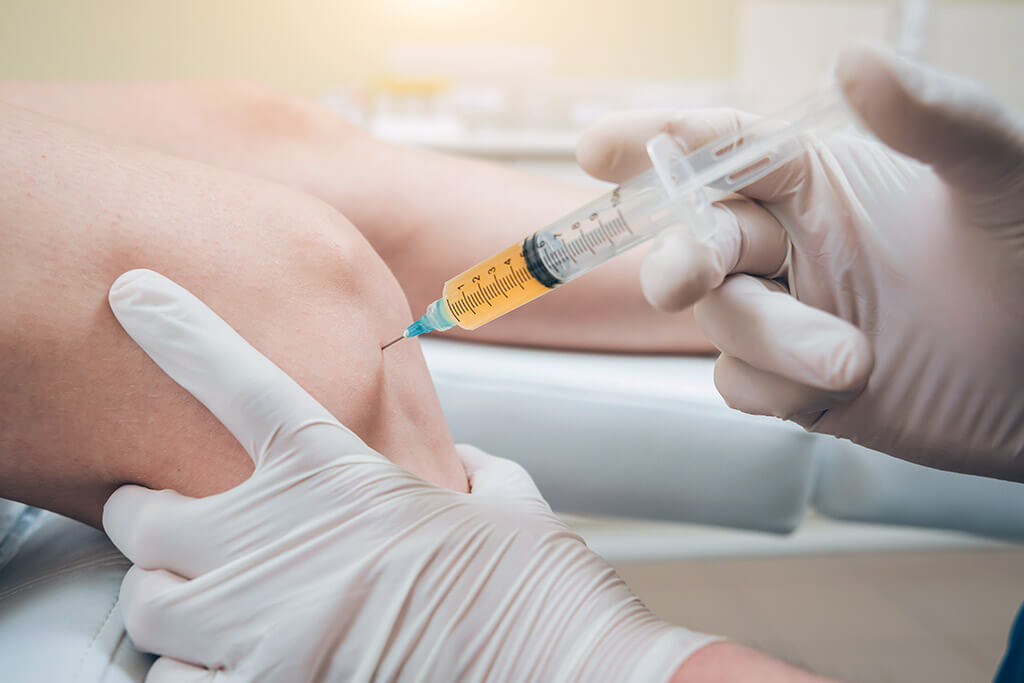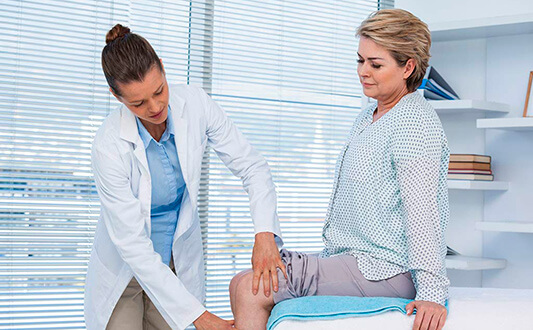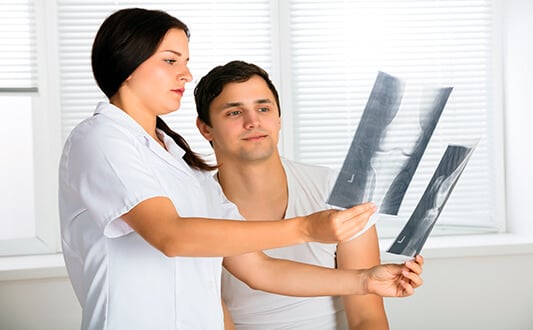Despite current advances in joint replacement and the availability of reliable prostheses, orthopedic specialists always prefer sparing a patient’s joint. Thus, restoration of the joint structures becomes the highest-priority task. Clinical trials have demonstrated the efficacy of cellular therapies, i.e. stem cell therapy, in this area. A patient's stem cells can create new cartilage and superficial bone layers when processed and introduced correctly. Structural material and nutrients are also used to enforce this process, making the second part of the autologous stromal vascular fraction (SVF) therapy combined with platelet-rich plasma (PRP) therapy.
Content
- Joint disorders and conventional approaches to their treatment
- Autologous stromal vascular fraction (SVF) therapy
- Therapy with platelet-rich plasma (PRP)
- Advantages and costs of combination SVF and PRP therapy
- SVF and PRP therapy abroad with Booking Health
Joint disorders and conventional approaches to their treatment
Osteoarthritis and cartilage defects are mentioned among the leading causes of disability worldwide, with higher prevalence in the elderly population. Despite the availability of diverse symptomatic treatment options (e.g. anti-inflammatory medications and exercises), a complete cure without surgical intervention is often impossible. Older people can poorly tolerate surgical arthroplasty and a joint replacement due to concomitant cardiovascular pathologies and other disorders.
Scientific efforts of the last few decades have been directed at developing regenerative therapies. The problem is that the articular cartilage has no supplying blood vessels and consists of few cells. Its regenerative potential is almost zero, i.e. cartilage never heals after mechanical injuries or inflammation. It is impossible to stimulate its restoration with the help of systemic treatments, as drugs in the blood do not reach cartilage. For this reason, the most effective way of introducing regenerative medications is their intra-articular injection. To be precise, hyaluronic acid that feeds cartilage and analgesics are also more effective when being introduced this way.
The first attempts in the sphere of articular cartilage regeneration included microfracture procedures. In this case, a surgeon makes small incisions or holes into the underlying bone of large joints. This improves the blood supply of the articular surface as new blood vessels arise in the damaged area. Blood carries nutrients, which is even more important. Thus, both damaged bone area and cartilage regenerate. Unfortunately, microfracture fails when we assess long-term results, as the new tissues continue wearing out, and regeneration is limited to a few months.
More targeted and efficient techniques are currently being developed that influence articular cartilage regeneration. This is autologous stromal vascular fraction (SVF) therapy combined with platelet-rich plasma (PRP) therapy. A combination of these techniques provides affected joints with both nutrients and stem cells without damaging the underlying bone or other joints’ structures. Let’s take a closer look at each of the therapeutic methods.
Autologous stromal vascular fraction (SVF) therapy
The autologous stromal vascular fraction is the source of stem cells that restore the damaged joint’s structures. The term "autologous" means that physicians harvest patients’ tissues and manufacture medications for other therapy from them. Autologous tissues are not rejected by the immune system, which is an additional advantage.
Simply put, SVF is part of adipose tissue. Thus, the first stage of SVF therapy includes liposuction. Liposuction can be performed in patients with obesity and normal body mass index. Patients with obesity-associated joint pathologies may benefit twice from the combination of liposuction and SVF cell therapy. The first procedure reduces body mass and mechanical joint load and provides physicians with stem cells, while the second one stimulates regeneration of the diseased joints.
Liposuction starts from anesthesia, and in most cases, the tumescent technique is used. This method permits local anesthesia of the subcutaneous tissues and skin by direct infiltration with large volumes of anesthetic solutions. The abdominal fat is most often aspirated in adults, and thigh fat is aspirated in children under 15 years. A tiny 2.4 mm cannula is used for manual aspiration.
The received lipoaspirate contains different types of cells, including the following ones:
- Adipose-derived stem cells (ADSCs)
- Progenitor cells of mesenchymal and endothelial tissues
- Subtypes of leukocytes
- Vascular smooth muscle cells
- Lymphatic cells
Lipoaspirate undergoes enzymatic digestion and further cultivation, so it contains a consistent amount of heterogeneous cells that is sufficient for repairing injured tissues and supporting neovascularization. ADSCs give origin to osteoblasts (that are responsible for bone formation), chondrocytes (that are responsible for cartilage formation), and tenocytes (that are responsible for tendons and extracellular matrix formation).
It should be noted that ADSCs can be more safely harvested in high quantities and are more stable genetically compared to bone marrow stem cells.
The processed SVF is indicated for a local joint application. These are intra-articular or periarticular injections. The first ones restore cartilage itself, and the second ones restore stromal loose connective tissue around the joint. SVF joint therapy is successfully used in patients with diseases of the shoulder joint, elbow, wrist joints, hand joints, hip joint, knee joint, ankle, and foot joints.
Therapy with platelet-rich plasma (PRP)
Platelet-rich plasma (PRP) is an autologous blood product that contains a concentration of blood growth factors. Due to their action, PRP therapy, also called treatment with autologous conditioned plasma (ACP), reduces inflammation and pain, improves joint function and slows down cartilage destruction. This is rather the symptomatic treatment that does not eliminate the cause of the pathology but temporarily improves the quality of a patient’s life.
Peripheral venesection and obtaining a moderate amount of a patient’s blood is the first stage of PRP therapy. To exclude the influence of food intake, a patient must fast for 4 hours before the procedure. Water intake is not limited. Up to 50 ml of venous blood is collected in tubes with an anticoagulant using aseptic techniques.
In most cases, veins of the upper extremity are punctured. Physicians proceed to its processing once a sufficient amount of blood is available. In specialized orthopedic hospitals, the medication is made in compliance with good manufacturing practices. The tubes are centrifuged at room temperature to separate blood into plasma and residual red blood cells. PRP fraction is located right above residual red blood cells and can be aspirated separately.
Autologous conditioned plasma is introduced intra-articularly. Under aseptic conditions, up to 6 ml of PRP are injected into the target joints. A local anesthetic may be applied if necessary. This is an outpatient procedure that requires only one hospital visit from a patient. Right after the procedure, a patient should make several movements in the affected joint. After that, he should refrain from physical exercise for about 24 hours.
Immediately after the injection, several regenerative mechanisms are triggered:
- Joint inflammation is inhibited, including the autoimmune one
- Production of synovial fluid increases, which prevents joint structures from mechanical damage
- New cartilage is formed more actively
- Pain receptors are blocked to a certain degree, which contributes to pain syndrome management.
In most cases, three injections of PRP are made at 1-week intervals. Although the overall duration of PRP action is limited to several months, it significantly affects the quality of life of patients with osteoarthritis. To make the effect of treatment more sustainable, orthopedic healthcare professionals combine it with SVF therapy.
Advantages and costs of combination SVF and PRP therapy
Combination of SVF and PRP therapy is currently the best option for treating degenerative and traumatic joint diseases. Their mechanisms of action are mutually complementary, so the symptoms reduce faster and remission is more stable. According to the results of clinical trials, combination therapy significantly improves Knee/Hip Osteoarthritis Outcome scores. The scale includes five fundamental indicators:
- The intensity of pain
- Painkillers per week
- Limping at walk
- The extent of joint movement
- Joint stiffness
Other advantages of the combination of SVF and PRP therapy include:
- Avoiding multiple hospital visits, as both liposuction and venous blood collection can be performed on the same day
- Eliminating the need for repeated anesthesia, as both injections and made at the same site and on the same day
- Easier regeneration against the background of reduced inflammation
- Absence of autoimmune response, as all the medications are autologous
- Good tolerability, low risk of complications
Currently SVF and PRP therapies are not included into the standard treatment protocol, so they are carried out only at hospitals that implement innovations into clinical practice. Leading hospitals that offer treatment with autologous conditioned plasma (PRP therapy) are represented in the table below. You will also find here prices for treatment:
| Hospital | Cost of PRP therapy for knee arthritis |
|---|---|
| Clinic of Advanced Biological Medicine Frankfurt am Main | €5,586 |
| Orthopedic Center Munich East Munich | €5,156 |
| ATOS Orthopedic Clinic Braunfels | €5,002 |
| ATOS Fleetinsel Clinic Hamburg | €5,077 |
| Clinic for Molecular Orthopedics Duesseldorf | €5,161 |
You will find the list of leading specialized orthopedic and general hospitals that offer treatment with stem cells in the table below. We also mention average prices here:
| Hospital | Cost of stem cell therapy for knee arthritis |
|---|---|
| Clinic of Advanced Biological Medicine Frankfurt am Main | €19,590 |
| Orthopedic Center Munich East Munich | €19,922 |
| Clinic for Molecular Orthopedics Duesseldorf | €20,242 |
The cost of PRP therapy in combination with SVF therapy is calculated individually, depending on the affected joint and degree of severity, patient’s age, rehabilitation measures and other factors.
SVF and PRP therapy abroad with Booking Health
As it has been already mentioned, the combination of SVF treatment and PRP therapy is carried out at specialized orthopedic centers and Orthopedic Departments of large multidisciplinary hospitals. Only limited healthcare facilities offer this kind of treatment, as they need their own high-technological laboratories to process patients’ blood and fat tissue before the intervention. People with degenerative joint pathologies often travel abroad to receive this therapy and postpone joint replacement. Those people who are not experienced medical tourists may use the help of Booking Health.
Booking Health is the international medical tourism provider that has been arranging modern treatment of people with osteoarthritis and other joint disorders from 75 countries in the world's leading healthcare institutions for more than 12 years.
When planning treatment abroad, Booking Health’s specialists offer help in such important aspects:
- Choosing one of the best orthopedic hospitals or departments based on the annual qualification profile of healthcare facilities
- Establishing preliminary communication directly with your future physician
- Preparing a program of treatment in advance, without repeating previous diagnostic procedures
- Providing favorable PRP and SVF therapy cost, without overpricing and extra charges for foreign patients (saving up to 50% of the initial price for foreigners)
- Booking the appointment on the necessary date, reducing waiting time
- Monitoring treatment at all stages, organization of additional examinations, etc.
- Help in buying and forwarding medicines for maintaining treatment
- Communication with the hospital after treatment completion, if necessary
- Control of invoices from the hospital and return of unspent funds
- Offering travel service of the highest level: booking hotels and tickets, transfer organization, etc.
- Services of interpreter and personal medical coordinator
To start planning SVF and PRP therapy, leave the request with basic medical and contact information on the website of Booking Health. A patient case manager or medical advisor will call you the same day to discuss all the details. Our work aims to help you in improving and maintain your health.
Choose treatment abroad and you will for sure get the best results!
Authors:
The article was edited by medical experts, board certified doctors Dr. Nadezhda Ivanisova and Dr. Sergey Pashchenko. For the treatment of the conditions referred to in the article, you must consult a doctor; the information in the article is not intended for self-medication!
Sources:
National Center for Biotechnology
WHO – World Health Organization
Read:
Why Booking Health - questions and answers
How to make right decision when choosing the clinic and specialist
7 reasons to trust to the rating of clinics on the Booking Health portal
Don't know where to start?
Contact Booking Health







